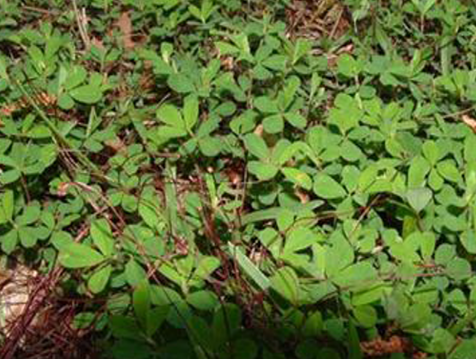History
Sericea lespedeza is an introduced perennial legume that was first recognized as a potential weed problem in southeast Kansas in the early 1980s. This plant was introduced into the United States by the USDA in 1900 for erosion control. In the 1930s it was planted on strip-mined areas in southeast Kansas, and in the 1940s and ‘50s was planted around State and federal reservoirs for wildlife habitat.
Sericea lespedeza
It is tolerant of drought, acidity and shallow soils of low fertility. It will tolerate soils ranging from very acidic to slightly alkaline, but prefers a ph of 6.0 to 6.5. It does best on clay and loamy soils that are deep, fertile and well drained, but will also grow on poor sites. Sericea lespedeza uses water less efficiently than many other warm-season plants and does best when annual precipitation is 30 inches or more. Frost will kill these plants, however, so they should not be planted until after the last frost of the spring. If cut off at the top, Lespedeza will stop growing up and spread out instead. When left to grow naturally, it is usually bush-like or stalky. The leaves are generally heart shaped. Flowers range in color from purple to light pink. Sericea lespedeza, once established, will reduce or eliminate competing vegetation. However, it is relatively slow to establish, having a rather weak and vulnerable seedling stage. Since it reseeds itself and is able to spread along the ground, Lespedeza is sometimes considered an invasive weed. Despite this, it is sometimes grown as an ornamental plant. More commonly, the plant is grown by farmers for feed or to reinvigorate the soil during crop rotation. Like most legumes, Lespedeza does not grow well in nitrogen-rich soil.
Beneficial uses of Lespedeza
Lespedeza is an ideal feed plant for sheep, goats and cattle. It is good for dairy cattle but should be used with caution. Evidence suggests that eating the plant after it has bloomed causes decreased milk production in lactating cows. Sericea lespedeza as a legume is recognized for its high levels of crude protein, but this is offset by high concentrations of chemical compounds called tannins. In addition to its effective uses in crop rotation, farmers also grow Lespedeza for pasture or to be cut as hay. General, the plant will provide less hay than alfalfa or clover, but it does have its advantages. First, it is less expensive to produce. Second, it provides quality pasture during the height of summer, when other pasture crops do not thrive.
Anthelmintic properties of Lespedeza
Resistance of gastrointestinal worms particularly the Haemonchus contortus, to chemical dewormers the need for alternative parasite control has become a topical issue for the Agricultural Research Services department of the USDA. Shaik, et al., 2006, carried out a research titled “Sericea lespedeza Hay As a Natural Deworming Agent against Haemonchus Contortus Infection in Goats“, proved that plants containing condensed tannins, such as Sericea lespedeza, may have some anthelmintic properties, but it is not known if preserving the forage will affect anthelmintic activity. Sericea lespedeza hay maintained anthelmintic activity when fed to goats. Feeding Sericea lespedeza hay to goats is an effective means of controlling parasitic nematodes and may be a potential supplement/replacement for chemical anthelmintics.
 By Milton B. Daley, Ph.D.
By Milton B. Daley, Ph.D.
Assistant Professor, College of Agriculture and Human Sciences
Visit us online at www.pvamu.edu/cahs

